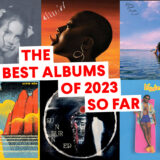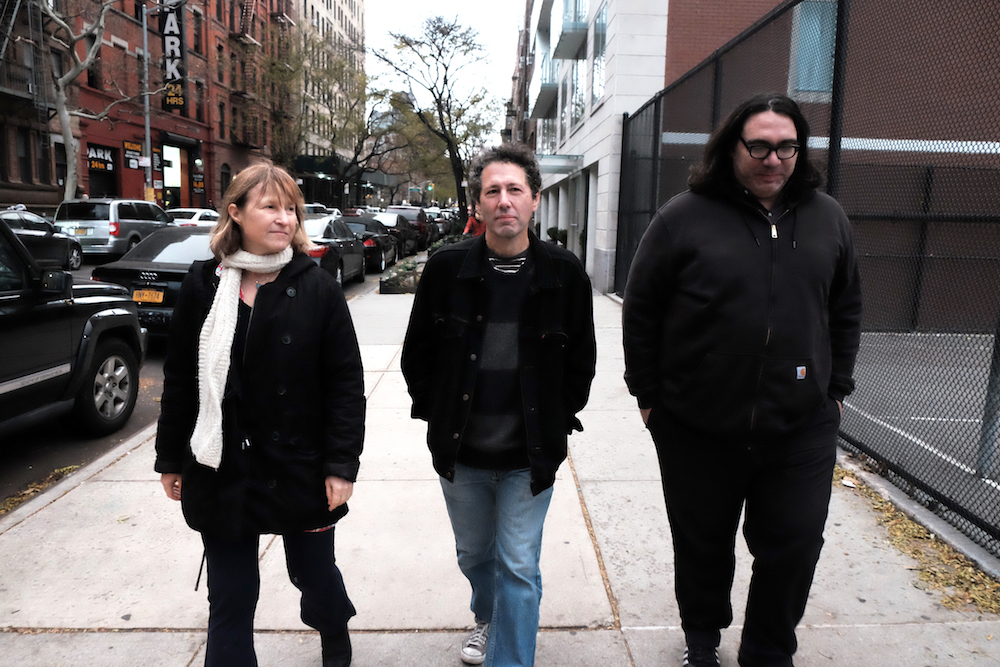Yo La Tengo was about halfway through “Out of the Pool,” the penultimate song from their forthcoming fifteenth album There’s a Riot Going On, when Ira Kaplan picked up his guitar. Like much of Riot, the song’s recorded version is vaporous, quietly churning; for its first half, Kaplan had been accompanying his bandmates using only a pair of shakers. His main instrument back in hand, he walked a few steps to his amplifier and dramatically cut through the atmosphere with the kind of lacerating atonal solo he’s been visiting on Yo La Tengo songs since first getting together with drummer Georgia Hubley three decades ago.
The band was playing a small pre-release show in Brooklyn for an audience of indie rock lifers and music industry types. Their transformation of a meditative new song like “Out of the Pool” into a vehicle for pure noise made for the most thrilling moment of the performance, channeling their scrappy origins at a venue where the crowd was largely middle-aged and a bartender mixed custom Yo La Tengo-centric drinks in the back corner. (“Green Arrow,” tequila with cucumber and lime; “Mr. Tough,” vodka with cinnamon and lemon.) The solo was also a reminder of the fundamental sense of possibility in Yo La Tengo’s music, a quality that sustained them even as many peers flamed out over the years, and that led them to making an album as quiet as There’s a Riot Going On in the first place.
“We might have had a feeling of, ‘Oh it would be nice to hear some crazy guitar,’” Hubley remembers a few days later, preempting Kaplan as he recounts the first time he played the solo at practice. They’ve been bandmates since 1984, married since 1987, and they have that tendency of longtime couples to talk over and under each other in a single stream, telling stories by incremental adjustment. “I can’t remember if you were there the day we did it,” Kaplan says, and Hubley answers, “In Hoboken, it was crazy loud.”

Also Read
The Best Albums of 2023 (So Far)
The pair lived there for years until a recent move across the Hudson River to New York, where they’re sitting right now, at the downtown office of their longtime label Matador. But the New Jersey city still serves as their spiritual homeland. “Yeah,” Kaplan finishes, conceding that his partner’s recollection is the correct one this time. “I remember consciously wanting it to be really, really harsh. Harsher than most of… just a burst of… Well, it was pretty unpleasant to listen to.” Everyone laughs. “And then we found a way to make it sound just right.”
In the context of Yo La Tengo, “just right” means the noise ended up being soothing instead of grating, beautiful instead of ugly. Ever since the early ‘90s, when James McNew entered as the trio’s fifteenth and final bassist after a long run of bit players, Yo La Tengo have found tenderness and soul in the sound of humming speakers and overloaded amps. There is a warm electrical haze at the periphery of their music, and it isn’t merely a stylistic accoutrement. The haze is an essential component, conveying a depth of yearning that their plaintive lyrics and melodies sometimes withhold. A song like 1993’s Painful opener “Big Day Coming,” which introduced this transcendent new version of Yo La Tengo after an early career filled alternately with folk-pop and skronky punk, is as much about the whale songs of feedback that happen between the words as it is about the words themselves.
There’s a Riot Going On brings the haze from its place of symbolic importance to the literal forefront of Yo La Tengo’s music. The easiest reference point is 2003’s Summer Sun, but even that melancholic and understated album hinges on a set of hummable tunes, whereas Riot contains long stretches that dissolve into wordless ether. For every track like “What Chance Have I Got,” a devastating Hubley-led ballad, there are two more like “Dream Dream Away,” which sounds a bit like Tom Petty’s “Free Fallin’” reimagined as ambient church music. The half-instrumental “Above the Sound” pulses gently around a repeated upright bass line, with a whiff of Alice Coltrane, whose Journey in Satchidananda partially inspired McNew to learn the instrument in 2015. Yo La Tengo’s Twitter bio currently reads “a monastic trio,” a sly nod to Coltrane’s first album, and perhaps to the hymnal quality of their own new material. As for the new album’s boldly referential title, they’re playing it coy: “The association is meaningful to us, otherwise we wouldn’t have chosen it,” Kaplan says, declining to explain further.
The sound of Riot might have something to do with the way Yo La Tengo assembled it, from musical odds and ends that McNew recorded during jam sessions: a looped few measures here, a stray echo there, removed from their context and layered with new music to become the shimmering, recombinant songs you hear on the record. It was the first time they’d worked so gradually, with so few distinctions between songwriting and recording, between a demo and a finished version in progress. Presented live in Brooklyn, the music was even more flexible, making room for extended vamps and amorphous improvised transitions. Given the abundance of handheld percussion onstage, it was easy to imagine the cocktail-shaker clatter emanating from the bar was a deliberate addition to the soundscape.
“When I first started playing in Yo La Tengo, I had been in bands before,” McNew says, back at the Matador office. “But I had never been in a band where it was like, ‘The next section of the song begins when we decide, when we’re ready.’ It was always, ‘Count to 16 and then change.’ That’s just who Ira and Georgia were, and it’s who I became. It’s a huge part of the way we play music: a real open approach.” Yo La Tengo’s members credit that openness in part for their longevity, staving off staleness and allowing them to be the kind of band that toiled at home for many years before the larger world started paying attention. “In 2000, we played at the Glastonbury festival on the new bands stage, with the Flaming Lips,” McNew quips. Each band had been around since the early ‘80s and was coming off the release of its respective ninth album. “It was like, ‘Hey, I really like your band! You’ve got a fresh new sound!’”
The openness manifests itself on a measure-by-measure level in the playing of the songs, but also in the larger decisions the band makes about its career, what Kaplan refers to as Yo La Tengo’s “unusual story arc”: the film soundtrack work, the record comprised entirely of four sprawling versions of the same Sun Ra composition. One paradoxical example was the Brooklyn show itself. The band generally opts for a freewheeling approach to live performance, drawing from their huge repertoire of originals and covers for a set list that changes drastically from night to night. But this one-off show had defined cues and a set of songs drawn exclusively from Riot, all plotted out carefully in advance.
The relatively closed-off format became its own kind of excursion. At their practice space, Kaplan grew accustomed to turning to his right to move from guitar to piano for a particular song change, but onstage, the piano was to his left. He remembers feeling disoriented for a moment, seeing Hubley and McNew as if they were unexpected faces turning up at a party somewhere, rather than the same people with whom he’d been rehearsing for weeks and sharing his life for decades. “I put my guitar down and started walking in the wrong direction, and oh look, there’s James and Georgia!” he says, smiling. “What are you guys doing here?”




